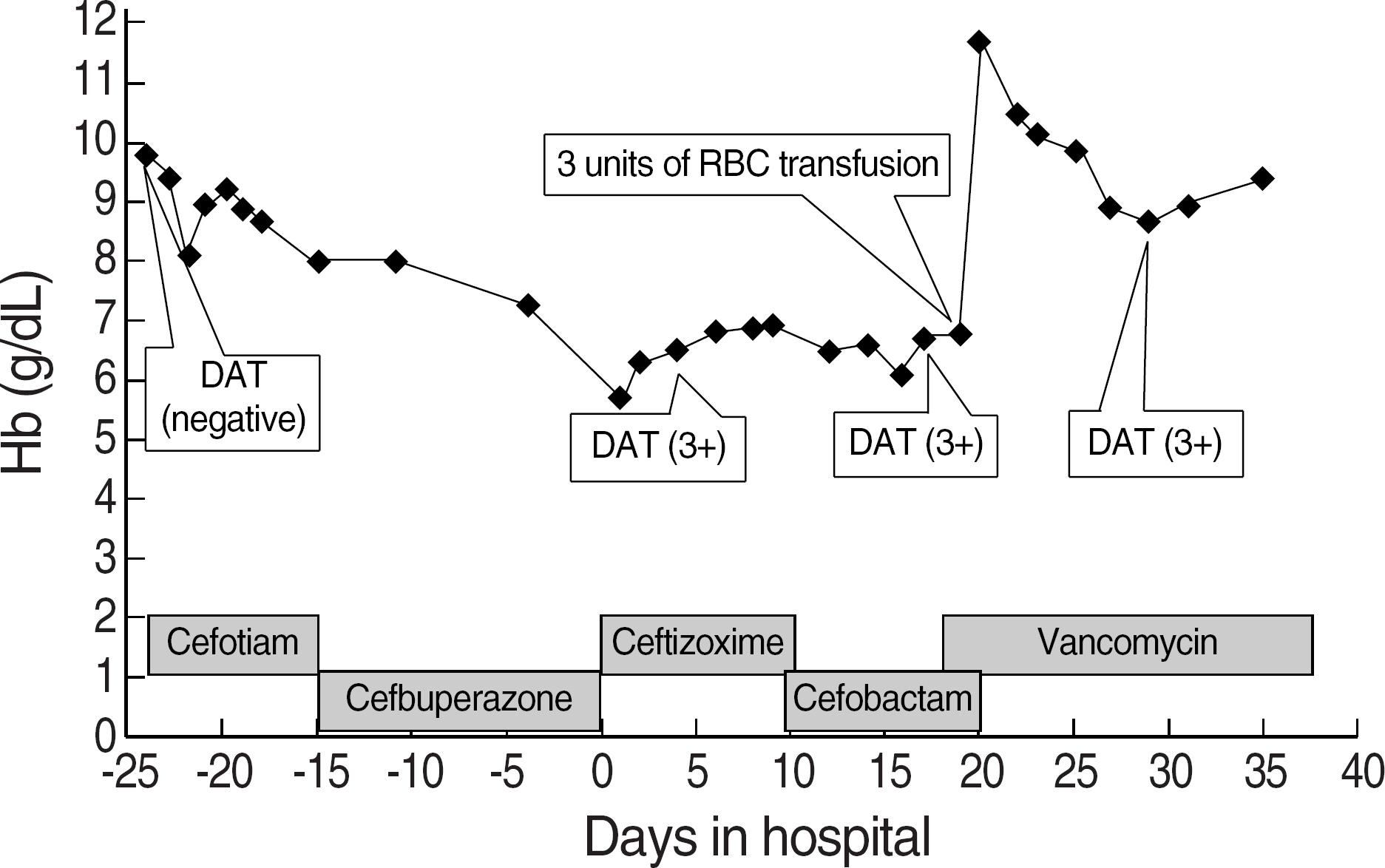Korean J Lab Med.
2009 Dec;29(6):578-584. 10.3343/kjlm.2009.29.6.578.
A Case of Immune Hemolytic Anemia Induced by Ceftizoxime and Cefobactam (Sulbactam/Cefoperazone)
- Affiliations
-
- 1Department of Laboratory Medicine, Yonsei University College of Medicine, Seoul, Korea. hyunok1019@yuhs.ac
- 2Seoul Red Cross Hospital, Seoul, Korea.
- KMID: 1781613
- DOI: http://doi.org/10.3343/kjlm.2009.29.6.578
Abstract
- Simultaneous drug-induced immune hemolytic anemia (DIIHA) caused by multiple drugs is rare. We report a case of a patient who developed DIIHA caused by 2 drugs. The patient's serum exhibited agglutination of ceftizoxime- or sulbactam-coated red blood cells (RBCs; via a drug-adsorption mechanism) and of uncoated RBCs in the presence of sulbactam (via an immune-complex mechanism). Although ceftizoxime is known to exhibit a positive reaction by an immune-complex method with or without reactivity with drug-coated RBCs, this patient's antibodies were reactive only against drug-coated RBCs. On the other hand, sulbactam, which is known to cause hemolytic anemia by nonimmunologic protein adsorption, exhibited positive reactions in tests with both drug-coated RBCs and in the presence of sulbactam. This is the first report of DIIHA due to a sulbactam-cefoperazone combination and the fourth report of DIIHA due to ceftizoxime. Owing to the patient's complicated laboratory results, DIIHA was suspected only at a late stage. We propose that for the prompt diagnosis of DIIHA, tests for all possible causative drugs should be conducted by 2 methods.
Keyword
MeSH Terms
Figure
Cited by 1 articles
-
Ampicillin/Sulbactam-induced Hemolytic Anemia Manifested as Hyperbilirubinemia in a Preterm Infant
Joo-Hyung Roh, Hey-Suk Yun, Hyun-Kyung Park, Hyun Ju Lee, Chang-Ryul Kim, Tae-Hee Han
Perinatology. 2016;27(3):190-193. doi: 10.14734/PN.2016.27.3.190.
Reference
-
1.Ahrens N., Genth R., Kiesewetter H., Salama A. Misdiagnosis in patients with diclofenac-induced hemolysis: new cases and a concise review. Am J Hematol. 2006. 81:128–31.
Article2.Johnson ST., Fueger JT., Gottschall JL. One center's experience: the serology and drugs associated with drug-induced immune hemolytic anemia—a new paradigm. Transfusion. 2007. 47:697–702.
Article3.Arndt PA., Garratty G. The changing spectrum of drug-induced immune hemolytic anemia. Semin Hematol. 2005. 42:137–44.
Article4.Kim S., Song KS., Kim HO., Lee HM. Ceftriaxone induced immune hemolytic anemia: detection of drug-dependent antibody by ex-vivo antigen in urine. Yonsei Med J. 2002. 43:391–4.
Article5.Shammo JM., Calhoun B., Mauer AM., Hoffman PC., Baron JM., Baron BW. First two cases of immune hemolytic anemia associated with ceftizoxime. Transfusion. 1999. 39:838–44.
Article6.Calhoun BW., Junsanto T., Donoghue MT., Naureckas E., Baron JM., Baron BW. Ceftizoxime-induced hemolysis secondary to combined drug adsorption and immune-complex mechanisms. Transfusion. 2001. 41:893–7.
Article7.Endoh T., Yagihashi A., Sasaki M., Watanabe N. Ceftizoxime-induced hemolysis due to immune complexes: case report and determination of the epitope responsible for immune complex-mediated hemolysis. Transfusion. 1999. 39:306–9.
Article8.Broadberry RE., Farren TW., Bevin SV., Kohler JA., Yates S., Skidmore I, et al. Tazobactam-induced haemolytic anaemia, possibly caused by non-immunological adsorption of IgG onto patient's red cells. Transfus Med. 2004. 14:53–7.
Article9.Garratty G., Arndt PA. Positive direct antiglobulin tests and haemolytic anaemia following therapy with beta-lactamase inhibitor containing drugs may be associated with nonimmunologic adsorption of protein onto red blood cells. Br J Haematol. 1998. 100:777–83.
Article10.Gehrs BC., Friedberg RC. Autoimmune hemolytic anemia. Am J Hematol. 2002. 69:258–71.
Article11.Drouillard DD. Transfusion therapy for autoimmune hemolytic anemia patients: a laboratory perspective. Clin Lab Sci. 2008. 21:7–11.12.Roback JD, Combs MR, editors. Technical manual. 16th ed.Bethesda: American Association of Blood Banks;2008. p. 893–934.13.Arndt PA., Leger RM., Garratty G. Serology of antibodies to second- and third-generation cephalosporins associated with immune hemolytic anemia and/or positive direct antiglobulin tests. Transfusion. 1999. 39:1239–46.
Article14.González CA., Guzmán L., Nocetti G. Drug-dependent antibodies with immune hemolytic anemia in AIDS patients. Immunohematology. 2003. 19:10–5.
Article
- Full Text Links
- Actions
-
Cited
- CITED
-
- Close
- Share
- Similar articles
-
- Ceftizoxime-induced immune hemolytic anemia associated with multi-organ failure
- A case of cefotiam-contact anaphylaxis
- Severe Hemolytic Anemia following Anti-D Immunoglobulin Administration for Acute Immune Thrombocytopenic Purpura in Two-month-old Infants
- Laboratory Workup of Drug-Induced Immune Hemolytic Anemia
- Cefuroxime Induced Immune Hemolytic Anemia


